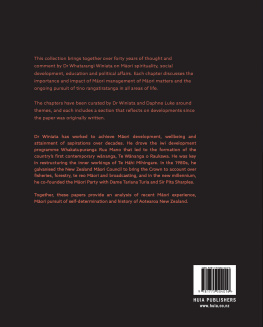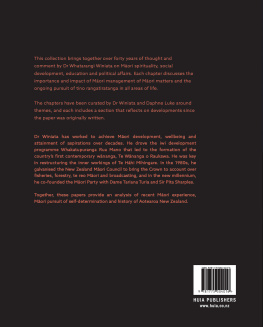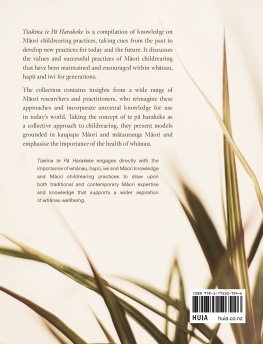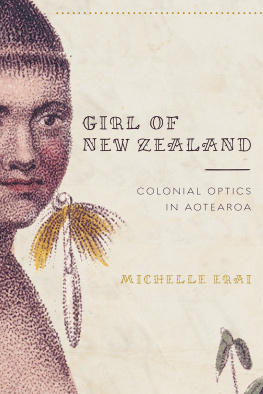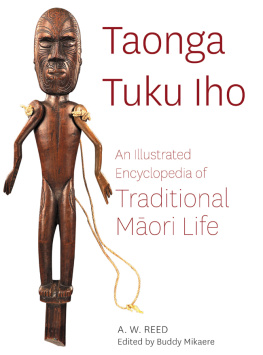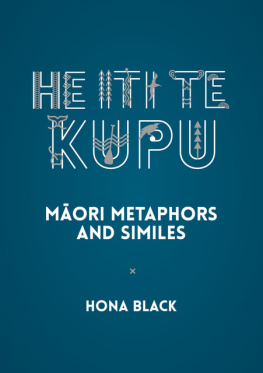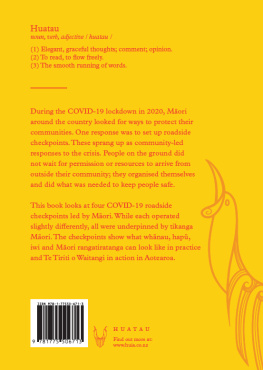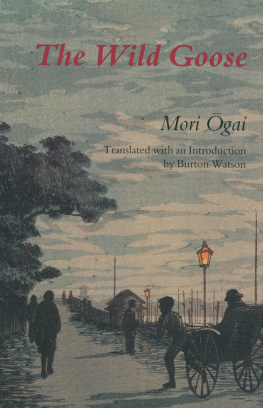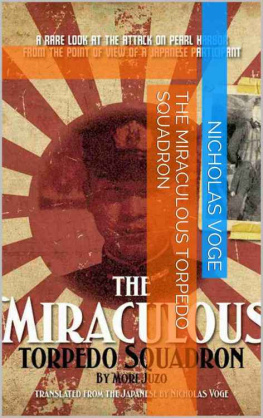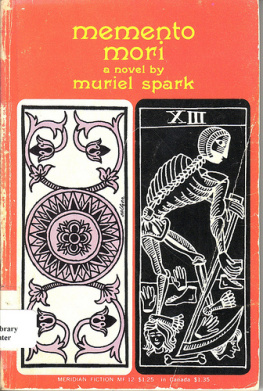- 4: The Theory of Managing Mana--hap and Mana--iwi Relationships:
The Long-term Survival of the ART Confederation as a Case Study (2000)
- 17: The Reconciliation of Kwanatanga and Tino Rangatiratanga
(Rua Rautau Lecture, 2005)
- 22: Perspectives on Partnership: Reducing the Socio-economic Disparities between the
Partners to Te Tiriti (1999)




THE SURVIVAL OF MORI AS A PEOPLE
A COLLECTION OF PAPERS BY EMERITUS PROFESSOR WHATARANGI WINIATA
First published in 2021 by Huia Publishers
39 Pipitea Street, PO Box 12280 Wellington,
Aotearoa New Zealand
www.huia.co.nz
ISBN 978-1-77550-401-6 (Paperback)
ISBN 978-1-77550-641-6 (Hardback)
ISBN 987-1-77550-501-3 (Ebook)
Copyright Whatarangi Winiata and Daphne Luke 2021 Cover image Te Taura Whiri i te Reo Mori
This book is copyright. Apart from fair dealing for the purpose of private study, research, criticism or review, as permitted under the Copyright Act, no part may be reproduced by any process without the prior permission of the publisher.
A catalogue record for this book is available from the National Library of New Zealand.
Published with the assistance of

Ebook conversion 2021 by meBooks
To the hap and iwi of the ART Confederation,
Ngti Raukawa, Te tiawa ki Whakarongotai and Ngti Toa Rangatira
and to Frances Winifred Mata Te Tai Awatea Aratema Winiata.
E kore au e ngaro, he kkano i ruia mai i Rangitea
Contents
4: The Theory of Managing Mana--hap and Mana--iwi Relationships:
The Long-term Survival of the ART Confederation as a Case Study (2000)
17: The Reconciliation of Kwanatanga and Tino Rangatiratanga
(Rua Rautau Lecture, 2005)
22: Perspectives on Partnership: Reducing the Socio-economic Disparities between the
Partners to Te Tiriti (1999)
Sir A pirana Ngata speaking at Raukawa Marae for the Rangitea Church centennial commemorations in 1950.
National Library/Unidentified Photographer 1/2-058067-F


Hirini Moko Mead and Whatarangi visiting in early 2020.
Image courtesy of authors
There was a time in our history as a nation, when education services provided to Mori were aimed at a number of desired outcomes. Mori people would become assimilated into the society of British settlers, lose their tribal institutions, forget their laws and customs, speak English and then ultimately qualify to become citizens of their own country. The settlers would decide when. Higher education offered to Mori was expected to grow the number of colonised and assimilated Mori leaders, who would then become advocates for the government of the day and its many institutions. In the case of Whatarangi Winiata, that did not happen, as a reading of his papers clearly indicates. At the time he was writing these papers and talking to a number of different groups of New Zealand citizens, he might have been considered a disappointment to Moridom, or even as a deserter, fighting for the Pkeh cause. A few people might have been excited by his ideas, and cautiously hopeful that he was acting as a bridge builder between Mori, the Crown, the government, and the dominant Pkeh population.
Read the papers in this collection and you will find that he is standing firmly as a Mori of Ngti Raukawa and his name is Whatarangi Winiata. He demands that Mori be Mori, that they reject the colonising and assimilating policies of the past and stand up in the t tangata mode that is, that Mori appear, act, think and just are Mori. These are revolutionary but logical ideas; the author of these fascinating papers stands out almost as a lone figure in reminding us all that survival is a big issue for Mori. Not the survival of individuals who might lose their culture along the way as they move at speed into the unknown future, rather, the survival of Mori persons who are clearly identifiable as Mori and who are living according to values and practices that are distinctly Mori (see Chapter 23).
He advocates that this is a policy we should take seriously. Why? Because we have been vulnerable ever since the settlers of Great Britain took charge of this land with the blessing of their Parliament. As pointed out by the author, living with the settlers and their democratic parliament-ary system, Mori have been relegated into being a vulnerable minority. Even though great progress has been made in improving relationships and building bridges of understanding, reaching the promised land of tino rangatiratanga as written in the Treaty of Waitangi remains out of reach. The author gives us the benefit of his thinking on these and many other issues. His advice is that we must be aware of our vulnerability and that everyone must do their bit to ensure that Mori survive as Mori, well into the future. Stated in te reo: m ng tau mutunga kore (for the years that never end).
The papers in this book span four decades, and if we phase in the birthing process that brought the authors ideas into te ao mrama (the world of light), we have to add another decade or two. Some ideas are constant, reappearing throughout the papers, such as the survival of Mori, and the development of hap and iwi in terms of cultural recovery and general wellbeing. Whatarangi Winiata is an educator, a trained economist and accountant, and a committed Mori scholar. He is also a man of the people; we take for granted that he is a man of Ngti Raukawa. He is very much a thinker, who brings to the table not just ideas but also models of organisation that help raise the level of discussion towards the top, to the tihi, of the mountain. This can be upsetting for some, uncomfortable for others and very exciting for some of us and some of them. There is the odd occasion when all parties reach the top of the mountain and a solution is reached.
I mentioned earlier that Whatarangi Winiata is a thinker. Actually, he is a leading thinker of the Mori world, and of te ao Pkeh as well. The result was the remarkable Whakatupuranga Rua Mano programme, which is described in Chapter 1 of this collection. At that time, he was employed by Victoria University of Wellington as a lecturer/teacher. He became involved with Te Hhi Mihingare, the Anglican Church in Aotearoa, New Zealand and Polynesia, and his influence within that organisation was huge. He has written about what he did and how his ideas took hold and changed the organisation and practices of the Church. His organisational model is clearly set out in these papers and provides much for the citizens of this nation to think about.
Another of his interests was working with the New Zealand Mori Council, and his influence within that organisation is yet to be documented. He breathed new life and energy into it only to see its potential whittled away through problems with human relationships. Hopefully, it will rise up again. Politics was another interest that occupied his mind for some years, and it was no surprise that he became chair of the Mori Party. He has spent years thinking about the Treaty of Waitangi and has always been passionate about the rights of Mori to actually experience tino rangatiratanga, in a way that our ancestors meant it to be as set out in the second clause of the Mori version of the Treaty of Waitangi.
Next page
